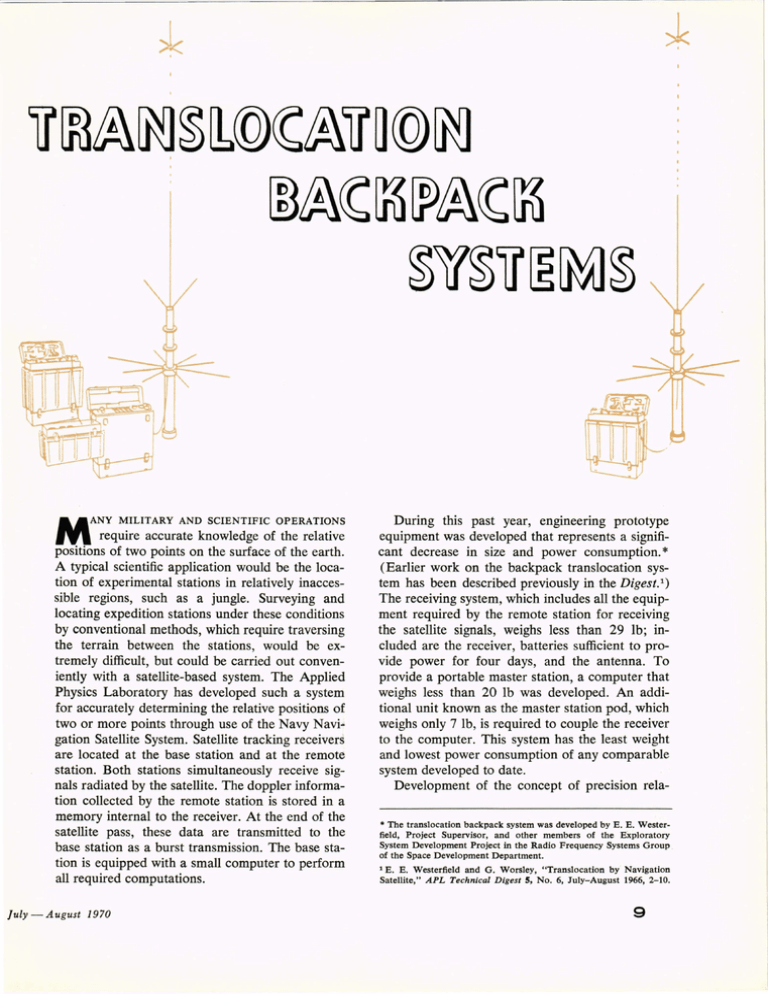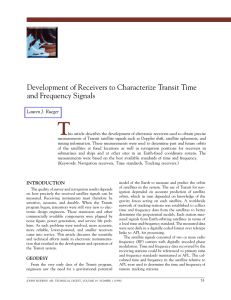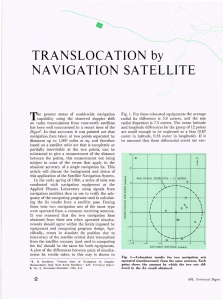M
advertisement

M ANY MILITARY AND SCIENTIFIC OPERATIONS require accurate knowledge of the relative positions of two points on the surface of the earth. A typical scientific application would be the location of experimental stations in relatively inaccessible regions, such as a jungle. Surveying and locating expedition stations under these conditions by conventional methods, which require traversing the terrain between the stations, would be extremely difficult, but could be carried out conveniently with a satellite-based system. The Applied Physics Laboratory has developed such a system for accurately determining the relative positions of two or more points through use of the Navy Navi.. gation Satellite System. Satellite tracking receivers are located at the base station and at the remote station. Both stations simultaneously receive signals radiated by the satellite. The doppler information collected by the remote station is stored in a memory internal to the receiver. At the end of the satellite pass, these data are transmitted to the base station as a burst transmission. The base station is equipped with a small computer to perform all required computations. July - August 1970 During this past year, engineering prototype equipment was developed that represents a significant decrease in size and power consumption. * (Earlier work on the backpack translocation system has been described previously in the Digest. 1) The receiving system, which includes all the equipment required by the remote station for receiving the satellite signals, weighs less than 29 lb; included are the receiver, batteries sufficient to provide power for four days, and the antenna. To provide a portable master station, a computer that weighs less than 20 lb was developed. An additional unit known as the master station pod, which weighs only 7 lb, is required to couple the receiver to the computer. This system has the least weight and lowest power consumption of any comparable system developed to date. Development of the concept of precision rela* The translocation backpack system was developed by E. E. Westerfield, Project Supervisor, and other members of the Exploratory System Development Project in the Radio Frequency Systems Group of the Space Development Department. E. E. Westerfield and G. Worsley, "Translocation by Navigation Satellite," APL Technical Digest 5, No.6, July-August 1966, 2-10. 1 9 tive location by use of the Navy Navigation Satellite dates back to 1963. The concept was originally developed for use with ship systems. Its usefulness for other applications, however, was obvious immediately. Tests run in 1964 between APL and Quantico, Virginia, using an AN/ SRN-9 doppler type radio navigation set showed the feasibility of obtaining accuracy on the order of 15 meters, using data from a single satellite pass. For the equipment to be useful to the military forces, it was essential that it be miniatuJ1ized with respect to both size and power. Equipment available at that time weighed a minimum of several hundred pounds and consumed hUlldreds of watts of power. The Laboratory therefore developed a portable receiver unit that was back-carriable to prove the feasibility of a portable battery-powered receiver. It weighed approximately 50 pounds including antenna, batteries, and other paraphernalia needed for field operation. The unit drew 12 watts of power. Computation was done on either a Honeywell H-21 computer, a small machine available in the Laboratory, or the FADAC computer, a machine specifically developed for the field artillery. More recently, the Laboratory was requested to develop equipment that was fully militarized, based on the portable APL equipment developed earlier. In addition, there was an indication of the necessity for reducing the weight from 50 pounds to less than 30 pounds. A contract was awarded the Aerospace Division of Honeywell Inc. in 1969 to develop a receiver meeting the requirements. The engineering model of this receiver was delivered to APL in December 1969 for evaluation, and satisfactorily met all of the requirements. Fabrication of four prototype receivers has recently been completed. Figure 1 is a photograph of the receiver with its antenna and battery. Included in the 29-lb weight is a back frame to allow the unit to be readily carried on the back. The small tube shown in the photograph houses the antenna and serves as a base for the antenna when it is set up. The total power requirement of this set is 6 watts. A standby power of 1~ watts is required for the oscillator. The computer selected to perform the required computations is a modified version of the CDC 449 computer (Fig. 2) which is organized in the nature of a general-purpose computer. The memory contains 4096 24-bit words. Two instructions are stored for each word, giving a theoretical total 10 Fig. I-Portable satellite tracking receiver. of 8192 instruction words. In practice, about 10% of the words are used for data storage. The computer includes a nine-digit display, one digit of which can be alpha-numerical. In addition, a keyboard is provided for use by the operator for controlling the operation of the system and the entry of certain data. Fig. 2-Portable computer. The computer operates from a battery identical to that used in the receiver. When operating, the computer draws 12 watts, 3 watts of which are required by the display. The battery has sufficient capacity to operate the computer for 18 hours continuously or to collect data and provide the computations for 54 passes. The batteries for both the computer and the receiver are readily replaceable by simply unfastening four latches. Preliminary testing of equipment accuracy indicates that single-pass errors less than 12 meters will be obtained when the stations are within 50 miles of each other. APL T echnical D igest







